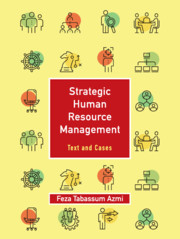Book contents
- Frontmatter
- Dedication
- List of Figures
- List of Figures
- List of Tables
- Preface
- Acknowledgements
- PART I The Framework of Strategic Human Resource Management
- 1 Concept of Strategic Human Resource Management
- PART II Context of SHRM
- PART III Strategy Formulation
- PART IV Strategy Implementation
- PART V Strategy Evaluation
- Index
1 - Concept of Strategic Human Resource Management
from PART I - The Framework of Strategic Human Resource Management
Published online by Cambridge University Press: 26 April 2019
- Frontmatter
- Dedication
- List of Figures
- List of Figures
- List of Tables
- Preface
- Acknowledgements
- PART I The Framework of Strategic Human Resource Management
- 1 Concept of Strategic Human Resource Management
- PART II Context of SHRM
- PART III Strategy Formulation
- PART IV Strategy Implementation
- PART V Strategy Evaluation
- Index
Summary
Chapter Overview
In this chapter, we will discuss the meaning and concept of strategic human resource management (SHRM). Various models and schools of thought in the area of SHRM are presented. The nature and characteristics of SHRM are also discussed. The chapter also sketches a picture of the emerging human resource (HR) scenario and the changes taking place in the field of human resource management (HRM). The different types of HR roles are also discussed. In the end, the challenges facing new age HR departments are highlighted.
Learning Objectives
To develop an understanding of the basic concept of SHRM and its different models and schools of thought
To gain insights into the changes taking place in the field of HRM and the consequent changes in the roles and responsibilities of HR managers
To understand the challenges that HR departments and HR managers have to face in this changing scenario
OPENING STORY
General Electric's Journey to ‘Imagination at Work’
John F. Welch, Jr., the iconic leader of General Electric (GE), gave new directions to the company when he took over as chairman and chief executive officer (CEO) in 1981. Welch embarked on an imposing challenge: building a revitalized ‘human engine’ to animate GE's formidable ‘business engine’.
At that time, GE was already one of the world's largest corporations built around 14 distinct businesses—including aircraft engines, medical systems, engineering plastics, major appliances, NBC television, and financial services. Soon after he became CEO, Welch articulated GE's now-famous strategy of ‘number one or number two globally’.
His programme had two central objectives. First, he championed a company-wide drive to identify and eliminate unproductive work in order to energize GE's employees. He developed procedures to speed up decision cycles, move information through the organization, provide quick and effective feedback, and evaluate and reward managers on qualities such as openness, candour, and self-confidence to create a lean and efficient organization. Second, and perhaps of even greater significance, Welch was instrumental in leading a transformation of attitudes at GE—to release ‘emotional energy’ at all levels of the organization and encourage creativity and feelings of ownership and self-worth.
- Type
- Chapter
- Information
- Strategic Human Resource Management , pp. 3 - 38Publisher: Cambridge University PressPrint publication year: 2019
- 3
- Cited by

